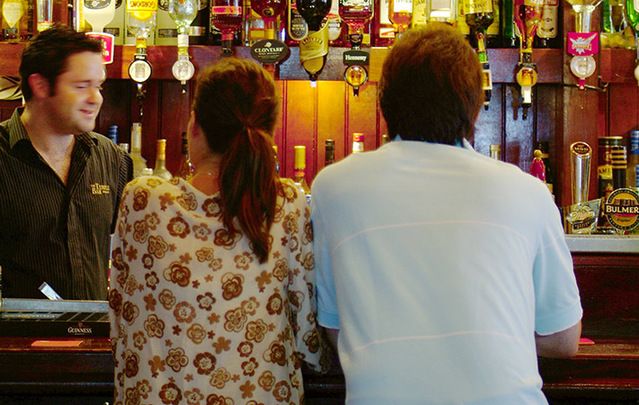Apart from the obvious misconceptions about Ireland, such as us all having red hair and freckles and behaving like extras from “The Quiet Man,” there are some facts about modern Ireland that go unnoticed by many.
From the changes in religious practices to our cuisine, immigration and Ireland's size here’s the low down on modern Ireland.
Some facts that will give you pause for thought:
Mass attendance
Despite largely remaining a predominantly Catholic country mass attendance continues to drop in Ireland. In the late 1990s, 64% of Irish Catholics attended mass on a weekly basis. By 2014 that figure has dropped to 42.1%, according to the Catholic Bishop’s report. By 2022 that figure had dropped to 40%.
In comparison, in the United States, according to Georgetown University, mass attendance stood at 24%, in 2014.
Rainfall
Yes! We never stop talking about the weather, but it’s really nothing to write home about.
The rainfall in Ireland does vary from coast to coast, but in Dublin there is on average 29 inches of rain per year.
In Seattle, which is also famously a rainy locale, they get 37 inches on average.
The difference is that Dublin has far more “grand soft days.” In Dublin, it rains 271 days out of the year, but in Seattle, it rains for only 150.
Size matters
The island of Ireland would fit snuggly in the state of Indiana.
It’s often said that Ireland “punches above its weight,” but many just don’t realize how small Ireland really is. Ireland is just 32,599 square miles. That’s 174 miles wide and 302 miles long.
The population of Ireland (north and south) is just 7 million (as of 2021). The United States population is 331.9 million and the whole of the United Kingdom is 68.8 million (2023).
This article was originally published in Ireland of the Welcomes magazine. Subscribe now!
Non-Irish
Immigration on a mass scale into Ireland is a relatively new thing. In 2002 the number of immigrants living in Ireland was 224,261. By 2011 this figure had risen to 544,357. That’s an increase of 143%
The number of immigrants to the State in the year to April 2022 is estimated to have increased by just above 85% to 120,700 from 65,200 when compared with 2021. The number of emigrants also increased over the same period to 59,600 from 54,000, according to the CSO.
In 2022, the number of immigrants was the highest since the year to April 2007 and consisted of 28,900 returning Irish nationals, 24,300 other EU nationals, 4,500 UK nationals, and 63,000 other nationals including Ukrainians.
Religious beliefs
In the 2016 census, 78.3% (3.5 million) of the population identified as Catholic. The next largest group after Catholic was "no religion" at 10%.
The country's Orthodox Christian, Hindu and Muslim populations have experienced significant growth in recent years, due chiefly to immigration, with Orthodox Christianity being the fastest-growing religion in Ireland.
Slave trade central
By the 10th century, Ireland became a hub for the slave trade providing labor and concubines from the British Isles to Scandinavia and even into Muslim Spain.
Following the arrival of the Vikings, who raided for treasure, goods and slaves, Dublin became a slave trade center. Recently, Dublin was linked to investigations into a portion of the Scottish population who can trace their ancestry to particular Saharan tribes whose ancestors came to Spain with the Moorish conquest and who were then captured in slave raids on Spain, taken to Dublin and sold as slaves to Scottish landowners sometime in the 9th century.
Irish food has improved dramatically
Long saddled with a reputation for meat and potatoes and little else, the Irish would beg to differ. But don’t just take our word for it. Irish chefs such as Kevin Dundon and Darina Allen are long-standing champions of Ireland’s exquisite, homegrown and made produce and wholesome cooking. We Irish are most certainly finding our feet on the world stage.
National Geographic did a feature on Irish food commenting on its “pervasive emphasis on quality, local ingredients and artisan producers.”
If you’re looking for wholesome, quality food Ireland is among the world leaders.
Scholarly land
Although Ireland has long been known as the “land of saints and scholars” there is often a misconception that Irish folks are just up for a bit of “craic” and a laugh. In reality, the Irish people are among the most educated in the world.
According to the CSO, among 25-64 year-olds in Ireland, bachelor's degrees are the most common tertiary attainment at 29% of the population followed by master's degrees with 14% and short-cycle tertiary qualifications with 9%.
Getting hitched
This may be another throwback to Ireland of “The Quiet Man” when the Catholic Church held a greater sway on the people, but many seem to think that the Irish marry young. This is not the case.
The average age of grooms and brides in 2020 was 37.8 years and 35.7 years respectively. The average age of grooms marrying for the first time was 35.7 years and for brides the average age was 34.2 years.
In the United States, by comparison, people still tend to marry in their 20s. The median age at first marriage for men was 29.9 years in 2015-2019, up from 28.1 in 2006-2010.
* Originally published in 2014, updated in May 2023.




Comments